Reformation in Conflict
(12) Council of Trent (1545) – Luther and other reformers had called for a universal council to be called in order to reform the church. It was not until after the separation between the reformers and the Catholics that Pope Paul III called for a council. At the request of the Emperor the council met in Trent in December 1545. The council of Trent did not consider a single issue, but every issue questioned by the reformers and tended toward the idea of uniformity in orthodoxy, a departure form the type of inclusive orthodoxy espoused by the earliest councils,. Such as Chalcedon, which had setup the boundaries within which orthodoxy could vary. The Council lasted until 1563 and made many decrees, reforming and transforming the Roman Catholic church and marked the birth of the Modern Catholic church.
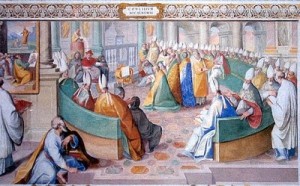
(13) Peace of Augsburg (1555) – The Peace of Augsburg was a sort of truce between the Emperor and his Princes. It ensure that the princes or rulers, both Catholic or protestant, we able toe chose for themselves the religion of their territories. The subjects who wished to migrate to a different territory based upon their beliefs could do so, this agreement included only the protestants who subscribed to the Confession of Augsburg, the others, including the Calvinists, were still considered heretics and subjected to persecution. This arrangement maintained a relative peace in Germany for more than 50 years until the 30 years war.
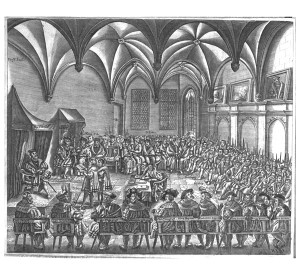
(14) Founding of the Church of Scotland (1558) – In 1557, in response to the pro-Catholic tendencies of Queen Mother Mary of Guise, the Protestant leaders in Scotland united and formed what became known as he Lords of the Congregation. They established ties with the English protestants and called John Knox back from Switzerland as they formed the Church of Scotland in 1558. Throughout conflict with French armies requested by he Queen Mother, Knox encouraged the protestants. Eventually the French armies withdrew and the Church Of Scotland was firmly established, despite the Queen Mother’s efforts to overthrow it.
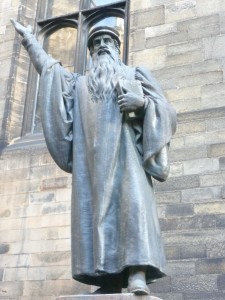
(15) Opening of the Genevan Academy under Beza (1559) – Under the direction of John Calvin, Theodore Beza founded the Genevan Academy, which would later become the University of Geneva. This was a lifelong dream of Calvin and it educated students under Calvinist principles. Under its influence, Calvinism was spread to almost every part of Europe leading to the founding of reformed churches in many countries. Under the direction of Beza even after Calvin’s death it continued to educate reformers for generations and sent them out in all directions.
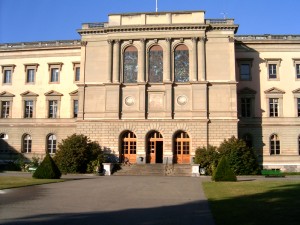
(16) Thirty Nine Articles promulgated by Queen Elizabeth (1562) – These articles serve as a the doctrinal foundation for the church of England. While it rejects several specifically Roman Catholic doctrines, it does not force a choice between any of the competing Protestant views. These articles laid the foundation for doctrinal inclusiveness of the Anglican church and those churches derived from it.
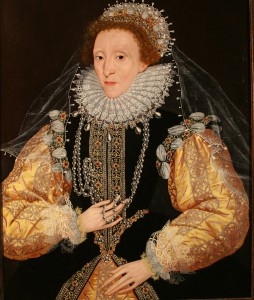
(17) Massacre of St. Bartholomew’s Day (1572) – In France, Protestantism had a very difficult an bloody start. The Kings variously supported and persecuted Protestants (known in France as the Huguenots). Charles IX, convinced that there was a Protestant plot to take his throne from him, and the leader of that plot being the French protestant leader, Coligny, ordered a massacre for St. Bartholomew’s day, August 24, 1572. Over 2,000 were killed in Paris and even in the Louvre itself, and the killing spread throughout the country, eventually resulting in tens of thousands killed, including entire families.
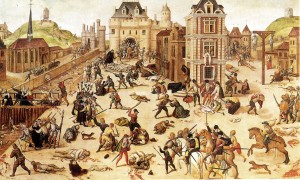
(18) Edict of Nantes (1598) – Finally after years of war, King Henry IV of France (the winner of the ‘War of the Henries’ – no kidding), though he had become a Catholic to win the French throne, did not forget his former faith. He proclaimed the Edict of Nantes and granted the Huguenots freedom of worship in all places where they had churches by the previous year, except Paris. They were allowed to keep the secured towns they had possessed by 1597. At least for a time, the bloody religious battles in France were over.
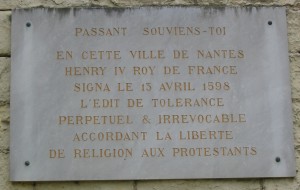
(19) Publication of the Vizsoly Bible in Hungarian (1607) – Much like the publication of the New Testament in German was beneficial for the German language, the publication of the Bible in Hungarian, the Vizsoly Bible, was beneficial to both the spiritual welfare of the Hungarian people and their language. This Bible was important for it provided a translation for a country in which as many as four fifths of the population was protestant.
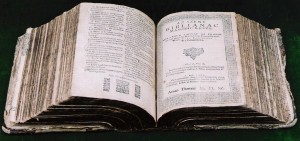
(20) Publication of the “Remonstrance” (1610) – The publication of the Remonstrance in 1610 in Holland documented the five articles under debate in Holland between Gomarus (a pure ‘Calvinist’) and Arminius (who appeared to disagree on some points with Calvin). The publication of the Remonstrance was you clarify the beliefs of the “Arminian Party” in relation to the Gomarus Party of the Dutch church. Since the church was supported by the government at the time, any potential heresy was akin to treason against the government, so the debate was very serious. This publication was designed to garner public support for the Remonstrant beliefs and clarify their beliefs in response to criticisms of heresy (such as Pelagianism). The matter would not be settled until the Synod of Dort.
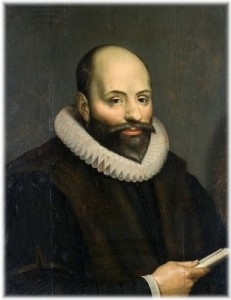
(21) Publication of the King James Version of the Bible (1611) – Despite the conflict between the Puritans in the House of Commons and King James over church government, they were able to collaborate to publish the King James version of the Bible in English. The English language was at a high point in its development. In 1611, Shakespeare had just finished writing the Tempest. The “thee’s” and “thou’s” of the King James Version (the KJV for short) would continue for years, continuing to befuddle young elementary students in the 21st century. The English language was standardized and only minor spelling changes were made to the text for many years.
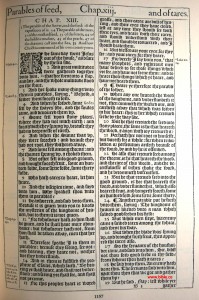
(22) Thirty Years War (Defenestration of Prague) (1618-1648) – The Peace of Augsburg was coming apart at the seams in the opening years of the seventeenth century. The Duke of Bavaria felt called to stamp out Protestantism and forcibly convert people to Catholicism. Bohemian Protestants revolted against the King of Bohemia’s representatives’ and threw them out of a window. The lived because they landed in a pile of manure. These events and a series of alliances and political maneuvering lead to a conflict involving all major powers in Europe in the bloodiest and most devastating war in Europe prior to the twentieth century.
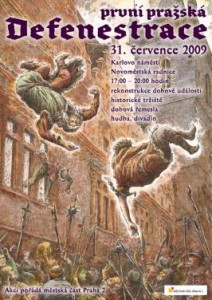
(23) Synod of Dort (1619) – In order to respond to the Remonstrants and their five articles, the Dutch called the Synod of Dort and invited theologians from reformed all over Europe to join in the council. The council responded to each of the five articles of the Remonstrants, crafting what as become known as the five points of Calvinism. (Calvinism of course, being made up of four books, has more than five points.) After the work of the synod, Arminianism, as the beliefs of the Remonstrants came to be called was condemned as heretical and those believing it were persecuted by exile or imprisonment. It was largely through other churches (such as Methodists) that the Arminian beliefs would gain strength.

Colonies and Revolutions
(24) Mayflower Compact and the Landing of the Pilgrims (1620) – The Pilgrims were Puritan separatists, who were seeking a place they could practice their religion as they wished. They had set out for Virginia, but ended up much farther North at Plymouth. The Mayflower compact was their first draft of a Government founded on their Puritan principles and morality, but still under the English King (though not the church of England). Their settlement barely survived that first winter, but it was their celebration of the following harvest that we now celebrate as Thanksgiving.
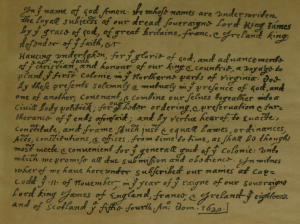
(25) Founding of the Massachusetts Bay Colony (1628) – Unlike the Pilgrims who founded Plymouth, the Founders of the Massachusetts Bay Colony were not separatists. They were seeking a place to follow more closely the practices they found in the new Testament, including the ideal rules of Government. They saw the colonies as a place they could seek to establish that new form of government without too much interference from England. The colonies ended up becoming a haven for Puritans as Archbishop Laud persecuted them in England.
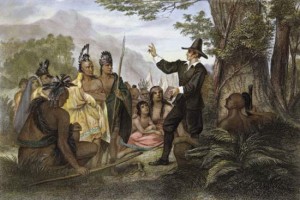
(26) Roger Williams Founds Rhode Island on Religious Freedom (1636) – Despite the Massachusetts Bay Colony’s desire to separate themselves from the influence of the English Government and to escape the persecution of the Puritans in England, the colony still enforced a particular religion upon the people. Roger Williams eventually founded the colony of Rhode Island in Providence based upon the ideas that “freedom is required as part of the very obligation to worship God. Worship must be sincere and all efforts to force it actually weaken it.” Williams believed there must be a clear separation of church and state in order to allow the proper worship of God and practice of religion. Eventually the church he founded became Baptist.
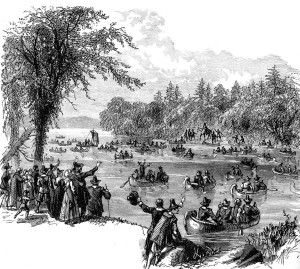
(27) Long Parliament Convened (1640) – In England, King Charles I was having difficulty in raising funds to fight against the Scottish rebels in the North so assembled what eventually became known as the Long Parliament. Instead of following his wishes, the Parliament declared that it could not be dissolved by the King without its own agreement. Then it began investigating the persecution of Puritans by the King’s men. This eventually lead to a civil war in England between parliament and the king. Both Charles and his Archbishop Laud (who had been so ardent in his persecution of the Puritans) were captured and executed. While it pursued war against the crown and justice against persecutors, parliament also took on the reformation and the ‘purification’ of the Church of England.
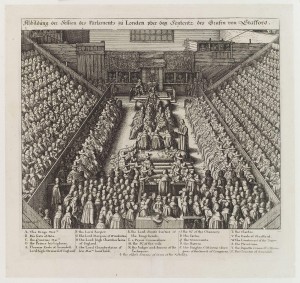
(28) Publication of Meditations on First Philosophy (1641) – No modern History of the Church could be complete without addressing the work of Descartes. In 1641, the work he is most widely known for was published, Meditations on First Philosophy. It was originally intended to answer the skeptics and critics who had claimed that the new reason and rationalism had rendered the need for God obsolete. Instead he ended up solidifying the skepticism of the time and his ideas (called cartesianism) promulgated the idea of universal doubt and the idea of separation of the soul and the body. His statement “I think therefore I am” is still giving undergraduate philosophy students (and graduate Theology Professors) much to write about today.

(29) Solemn League and Covenant (1643) – When the Long Parliament was at war with the King, Irish Catholic troops were joining the King’s royalist forces. Parliament sought an alliance with the Scottish rebels . The Scots promised to aid Parliament on the condition that the Scottish form of Church Government (Presbyterianism) was adopted in England. While this document as a treaty would not hold the alliance for very long, it began changes in the Church of England that would affect the Westminster confession later released by parliament. It virtually assured that the form of government espoused in the Westminster Confession would be Presbyterianism.
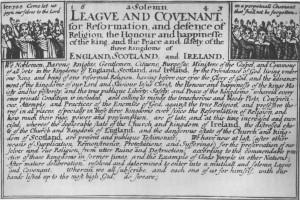
(30) Westminster Confession Published (1646) – Parliament convened an assembly to restructure the church of England. Representatives from both England and Scotland participated in the development of a creedal confession (the Westminster Confession of Faith, WCF) and associated catechisms (larger and shorter). Though these documents were rejected when the Monarchy was restored in 1660, the Scottish church, the Presbyterian Churches around the world and many other denominations still use the Confession as their creedal statement, often requiring some level of subscription to its statements for their pastors. The confession presents statements similar to the Synod of Dort, but is more comprehensive in its coverage, including issues primarily relevant to the current time in England.
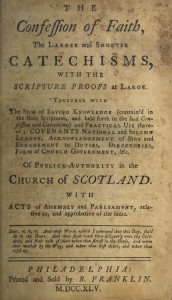
(31) Peace of Westphalia (1648) – After the death of Ferdinand II in 1637, a long and complicated negotiation began that resulted in the Peace of Westphalia, ending the Thirty Year’s War. Sweden and France were granted large portions of Land, and the power of the German Princes were increased with respect to the Holy Roman Emperor in order to balance the Emperor’s influence. All people were then allowed to follow their religion (as long as they were Catholic, Lutheran or Reformed). But the war also led to the founding of the modern state that ignored religion in order to prevent the sort of bloodshed that resulted from it during the Thirty Years War.
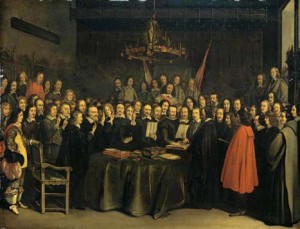
(32) Spener begins “colleges of Piety” (1670) – Jakob Spener has been called the father of Pietism, though the roots of Pietism precede Spener. Pietism was a “response to the dogmatism of the theologians and the rationalism of the philosophers” and the Thirty Years War, and it emphasizes the living faith that is at the heart of Christianity and demonstrated in a holy life and works. As a Pastor in Frankfort, he began groups of Bible study and devotion that he called colleges of piety and devotion. In his book about these groups, Pia Desideria, he emphasized the need for the laity to be devoted to study of the scriptures and to go beyond the dogma into a personal obedience to the scriptures. It was the pietist followers of Spener who first began to send protestant missionaries out to foreign lands.
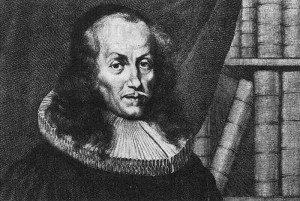
(33) The Great Awakening (c. 1734-1742) – The Pietism movement eventually reached the shores of England and especially America causing a revival movement called the Great Awakening. Many of the leaders of the Great Awakening were orthodox Calvinist who underscored the need for an experience of conviction of sin and divine forgiveness. Through the preaching of Jonathon Edwards, and then George Whitefield, and Wesley in England (and occasionally in America) thousands were converted and many churches were renewed in spirit. While the movement was begun by the Congregationalists and Presbyterians, it spread to the Baptists and Methodists who took t to the frontier where those denominations became most numerous.
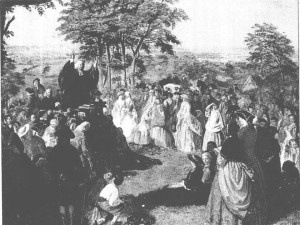
(34) John Wesley meets the Pietists (1735) – One of the most important Pietists in terms of impact upon the later church was John Wesley. He had grown up in England, the son of an Anglican priest, and he had studied at Oxford where his brother had founded a religious society that came to be known as the ‘Holy Club.’ Wesley met a group of Moravians (a Pietist group) on his way to Georgia to take up a preaching position and their faith had greatly moved him. When he returned to England after failing at his preaching position in Georgia he sought out the Moravians. Peter Boehler became his spiritual advisor. While his experience with the Moravians brought him assurance in his salvation and an appreciation for their faith, he stayed in the Anglican church and began preaching during the Greta Awakening at the behest of George Whitefield. Wesley’s pietistic influence is still felt in many of the denominations today that were founded on his beliefs and ideas.
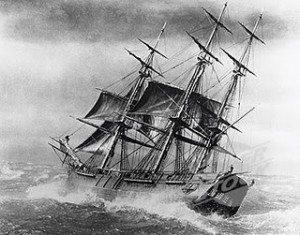
(35) American Revolution (1776) – The American revolution greatly affected the church, both negatively and positively. Negatively, John Wesley and other English preachers spoke out against the rebellion of the colonists and called for Christians to refuse to join the rebellion. The Pope spoke out democracy and as late as 1864 the Pope condemned the democratic form of government practiced in the United States (Syllabus of Errors). Many of the churches were founded in terms of a national church within a single nation ended up creating uniquely American churches. The Presbyterian Church of the USA, The Protestant Episcopal Church (Anglican), American Methodists (after 1776, the British Methodist Pastors all left for England) were all created shortly after the revolution began. In the midst of the separations, the Unitarian church was founded by those with more rational and deistic beliefs. For better or worse the America churches were now on their own.
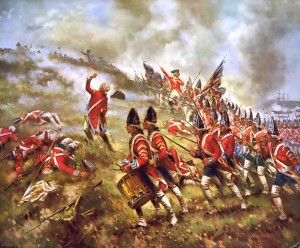
The Creation of the Modern Church
The power of ideas to shape the world…
(36) Publication of Critique of Pure Reason (1781) – The publication of Kant’s Critique of Pure Reason changed how people thought of knowledge. Kant declared that our knowledge of things is not things as they actually are themselves, but rather things as we are able to grasp them. In Kant’s theory there is no such thing as purely objective knowledge, and the pure rationality of the Cartesians, Empiricists and the Deistis is an illusion. If knowledge is understood in this manner, than it renders many of the traditional arguments for the existence of God no longer valid. Furthermore, it goes beyond Descartes’ grounding of existence in Human thought to suggest that all knowledge is personal and that wisdom begins in a man’s perception of the world, which may be flawed and influenced by many other factors. Kant’s ideas are still changing how people think about religion and epistemology today.
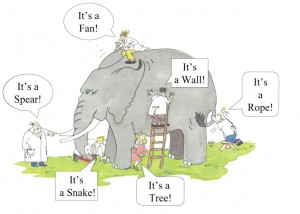
(37) William Carey Founds The Baptist Missionary Society (1792) – If there is a single event that starts Modern Protestant missions, then it is the formation of the Particular Baptist Society of Propagating the Gospel amongst the Heathen (Later shortened >whew!< to The Baptist Missionary Society) by William Caery. This example lead to the establishment of a number of other missionary societies in other denominations. Carey was a teacher and a cobbler by trade, but had a fascination for foreign lands and culture. When the Baptist Missionary Society could not find someone else to send as a missionary, he himself went to Calcutta and began missions there. He adopted many local customs and worked to translate the scriptures into local languages, and worked to train local pastors to work with the Natives. Carey’s methods are still mimicked today in many missionary efforts.
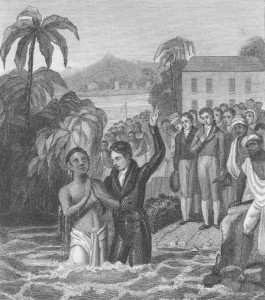
(38) The Second Great Awakening (1800-c.1840) – The Second Great awakening began on the frontier of America and resulted in the founding of a number of societies whose mission it was to spread the Gospel. The Cane Ridge Revival in Kentucky was an large outdoor camp revival meeting attended by thousands. While many came for the religious services, many also just came to gather and some claimed there was as much debauchery as religious conviction. Later waves of the Second Great awakening would involve Baptist and Methodist preachers organizing similar camp revivals periodically. These revivals became common place and part of frontier life. Furthermore the Second Great Awakening began to breakdown the strict correspondence between ethnic origin and religious affiliation, allowing the individual to chose their own religious ties.
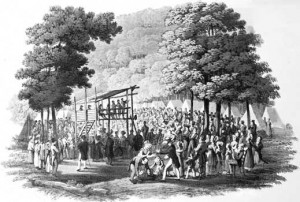
(39) Founding of the Methodist’s Ladies Home Missionary Society (1835) – A Significant characteristic of the Second Great Awakening was the participation of women in the revivals and in founding the missionary societies and other social organizations. In 1835 Phoebe Palmer, a leader in the Holiness movement founded the “Methodist’s Ladies Home Missionary Society” to work in some of the most deprived urban areas of the nation. This society served as a model for many other women’s organizations in other denominations and contributed ideas to what would later become the American feminist movement.
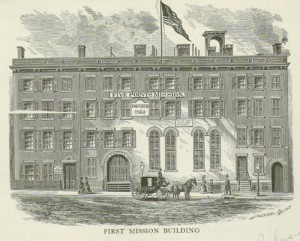
(40) Publication of Origin of Species published by Darwin (1859) – The publication of the Origin of Species would seem like a relatively innocuous publication of a Scientific work, but the theory of evolution presented by Darwin to many seemed to be a direct contradiction to the story of creation as recorded n Genesis. This direct contradiction of science and religion made a debate that had largely been abstract and philosophical into something more concrete and significant. Was Science or Faith to hold the final interpretation? This lead to various historical critiques of scriptures, and a reaction within Christianity varying from one extreme to another. Some pastors were (and still are) forced to declare their position on the theory as a determination of the correctness of their theology. These debates are still being widely held in America today.
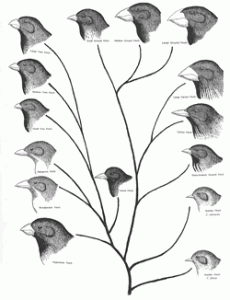
(41) American Civil War (1861-1865) – The American Civil War lead to the break up of many churches into North and South divisions, usually over a response to slavery. Many southern churches sought to support the rights of whites to own slaves and sought proof in the scriptures, while the abolitionist movement was very strong in the North and had support of most of the Churches in the North. After the war it took some churches many years to rejoin their split denominations (the Presbyterians took 115+ years to rejoin their branches!).
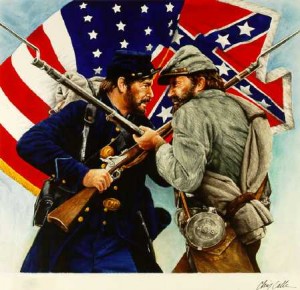
(42) First Vatican Declares Papal Infallibility (1870) – Under Pope Pius IX, the First Vatican Council promulgated the doctrine of Papal Infallibility, stating that when the Pope speaks ex cathedra, then he is “possessed with that divine infallibility …promised to him in blessed Peter.” In actuality this doctrine has only been exercised once since its declaration (that to promulgate the doctrine of the Assumption of Mary in 1950). Some churches withdrew from the Catholic church and founded the Old Catholic Church, but the declaration did not cause a large stir at the time, the Papacy by this time had lost most of its political power. Before the end of the year Rome would surrender before the armies of Italy.
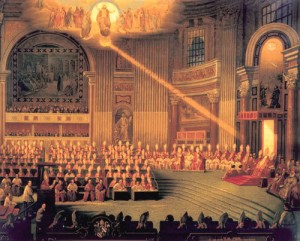
(43) Evangelical Alliance in Niagara espousing Fundamentalism (1895) – Darwin’s theory of evolution and the historical and critical studies taking place in Europe seemed to raise doubts about the scriptures and gave additional impetus to the rise of Liberalism in the United States. The Evangelical Alliance in 1846 was formed to combat liberalism in the Church and in 1895 they published the five fundamentals that could not be denied “without falling into the error of liberalism.” They are the inerrancy of scripture, the divinity of Jesus, the virgin birth of Jesus, Jesus’ death on the cross as a substitutionary atonement for our sins, and finally Jesus’ physical resurrection and impending return.

(44) Azusa Street Revival (1906) – A former slave, William J. Seymour, who had been profoundly affected by the Pentecostal preacher, Charles Parnham, began meeting with a group of believers on Azusa Street in Los Angeles. There were sudden manifestations of the Spirit, including speaking of tongues. Inspired by the events, Seymour and his followers began meeting in a large location on Azusa street. From there the movement spread out into both Whites and Blacks across the nation. Eventually a gathering of believers in the “baptism of the Holy Spirit” was called and there the Assemblies of God church was formed. The revival of Christianity now seeping through the ‘third world’ is largely a Pentecostal movement that can trace its roots back to the humble home of a former slave in Los Angeles.
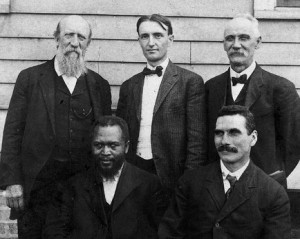
(45) Scofield Bible was published (1909) – Fundamentalism insists upon the inerrancy of scriptures, and some circles this lead to a more literal interpretation of scripture and to the formulation of new schemes of explaining Scriptures and God’s work in the World. Cyrus Scofield developed a popular scheme which became known as Dispensationalism, and divided the whole of human history into 7 dispensations, the current being the sixth of the seven. This interpretation was published in the Scofield study bible and was popular in fundamentalist circles, closely linking fundamentalism with dispensationalism.
(46) Founding of Westminster Theological Seminary and Orthodox Presbyterian Church by Machen (1936) – In response to the growing threat of Liberalism many fundamentalists decided to take action. When their actions could not reverse the impact of Liberalism on their institutions they broke away to create new ones. J. Gresham Machen was a Princeton Professor who lead one such split to create the Orthodox Presbyterian Church and Westminster Seminary, a denomination and seminary devoted to the fundamentals of the faith and their preservation in the face of liberalism. Other schisms of the same sort occurred in many denominations.
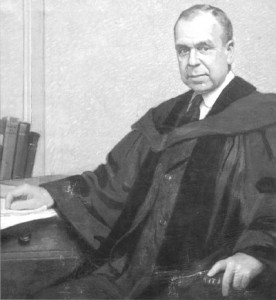
(47) First Assembly of the World council of Churches at Rotterdam (1948) – The Founding of the World Council of Churches was the culmination of years of work begun in 1910 at the first World Missionary Conference in Scotland. The goal was to provide some ecumenical unity for the World church across both the western and the ‘third world’ nations. One hundred and seven churches from forty-four nations were part of the first council. The council sought to be inclusive and seek common ground, eventually even adding Eastern Orthodox churches to the rolls.

(48) Second Vatican Council (1962) – Pope John Paul opened the Second Vatican Council by calling the council members to “respond to the concerns of the modern world with words of understanding and encouragement rather than blistering condemnations.” Of the council members 42% were from Latin America, Black Africa and Asia. The council, which met over several sessions and years, eventually modernizing Catholicism significantly. The council authorized the vernacular languages for us in most liturgies, emphasize the notion of the church as people of God, both laity and clergy and rejected traditional prejudice against the Jews, acknowledging Christianity’s roots in Judaism.

(49) The Chicago Declaration (1973) – In the spirit of the creeds and decrees of previous generations, the a group of leaders of the Evangelical movement joined n the Chicago Declaration, which espouses the beliefs that a vibrant Christian faith calls upon Christians to critique the existing economic and social order. It called on Christians to be active in fighting for justice in the face of injustice, for attacking materialism in the culture both nationally and internationally. Its importance in calling Christians to action should not be understated. Future movements of the “Christian Right” likely grew out of this type of thinking if not directly from this declaration.
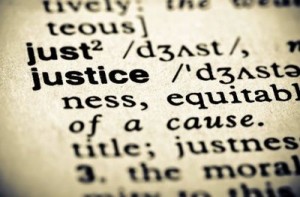
(50) The Collapse of communist Rule (1989) – Gorbachev’s policy of Perestroika and the collapse of Soviet influence in lead to greater freedom for churches that had been oppressed for between 50 and 80 years. After all the oppression suffered under communist rule the world was surprised to see the massive growth and the force of Christianity in the formerly Communist regions. In 1989 alone, more than 1,000 orthodox communities emerged and seminaries opened in Belarus and Siberia. In other countries formerly under Soviet rule similar events happened as the Churches gained freedom to worship. Perhaps the power of liturgy and tradition, given such a high place in the Eastern an Russian Orthodox churches, could be a significant tool to help the Western Churches preserve traditions and faith in the face of persecution and social ambivalence.

Division and schism, open ideas and government oppression, war and peace, poor teaching, dogmatism… nothing will stop the Church of Christ from carrying out the Mission of God.
The Lord’s Song of Victory
The Lord said unto me, “Be not afraid,
The plans that I have made for you will be
And on that day a conq’ror you will be–
Your crown to cast before your Christ is made.
Not smoking, pride, divorce, or anger frayed,
Nor shaped by fame and fortune will you be,
Not reason’s courteous handmaid will you be–
Rather from grief and spite I have you saved;
To show that not from darkness is your start,
But from my very song of victory,
Sung before the age of men and death;
And now a servant, son to me you are,
To you, a God and father I will be.
Now sing! My Victory in every breath.
– Ken McAfee 2/3/2012
Before
My world, a mystery formed before the time
To measure it was set in endless motion.
I found my form in His eternal rhyme
In God’s immutable immanent passion.
And I, I fall here, lost upon the face,
I’m cast adrift on depths of finite craves;
To touch, to taste, a trace of infinite grace
In things too small, too weak, in things depraved.
I strive, I seek, to stand, and yet be filled;
My heart, my soul, my mind the chaos craved.
You are, you call! Uphold in me, fulfill.
You come. I am undone, united and remade .
So take me, make me, finish the work begun,
Before we knew the taste of grace undone.